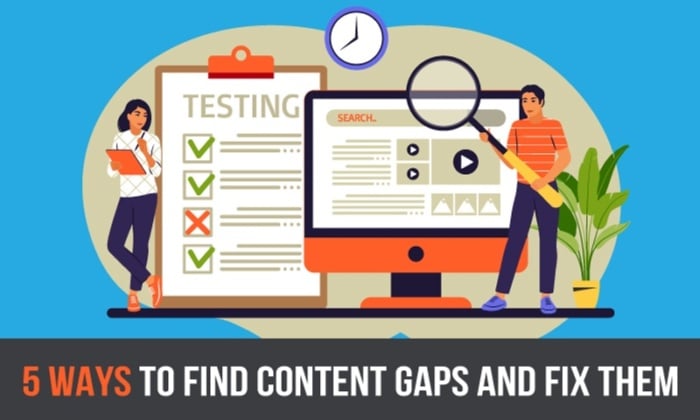
You can be a prolific writer or have the most productive content marketing team in the world.
Even then, there’s always a possibility that your website has “content gaps”—and the best of any marketing strategy can fail unless you fix them.
The trick is learning how to identify content gaps and knowing what to do when you find them.
What Are Content Gaps?
Content gaps refer to the topics your target audience is looking for that are not currently covered on your website.
Content gaps are common. After all, there are only 31,000 keywords with monthly search volumes exceeding 100,000 searches according to Ahrefs—but there are over 200 million keywords that have between 10 and 1,000 monthly searches.
Depending on your industry, there are potentially thousands of topics your target audience is searching for that you may not be covering.
For example, say you’re an SEO agency that has dozens of blog posts on advanced SEO techniques. However, you notice readers are bouncing from your pages quickly far too often.
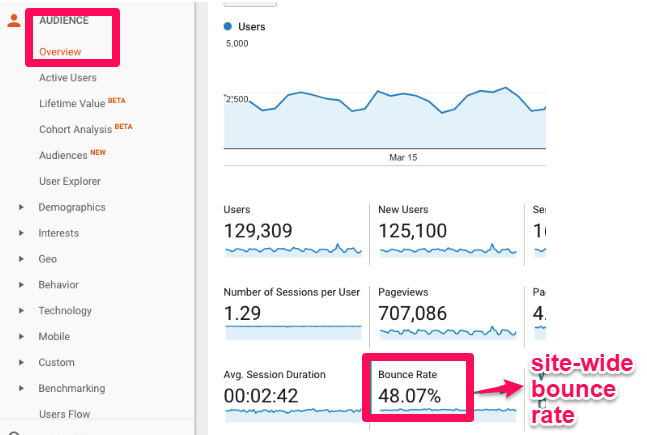
You wonder why that could be. Is your content not engaging enough?
A quick content gap analysis may help you realize you have gaps in your current approach. It could turn out your target readers are looking for basic SEO techniques while you’re currently offering higher-level stuff that they can’t quite grasp yet.
In cases like this, identifying and fixing content gaps can help you retain readers and increase the chances of them converting.
Why Is It Important to Identify Content Gaps?
Identifying and fixing content gaps sounds like a lot of work, but the results are worth the effort.
- Improved SEO: Identifying and fixing content gaps can help improve your site’s ranking on search engines. This is important because 88 percent of searchers only visit links on page 1 of search engines like Google.
- Better connect with your target readers: Fixing content gaps can give your readers exactly what they’re looking for, thus establishing a connection with your site. It’s important and possible to build a relationship with your audience—64 percent of people say they have a relationship with a brand.
- An optimized buyer journey: Identifying and fixing content gaps can reduce bounce rates, increase on-site time, and potentially improve your conversion rate, resulting in more sales.
What Are the Different Kinds of Content Gaps?
Not all content gaps look the same, but identifying and understanding them is key to fixing any ongoing issues.
Keyword Gaps
Not all keywords are created equal.
For instance, the CTR for the top spot in Google for one-word search queries is 32.5 percent, which is higher than the CTR for long tail keywords. However, starting at position two, the CTR for long-tail keywords is higher than the CTR for one-word queries.
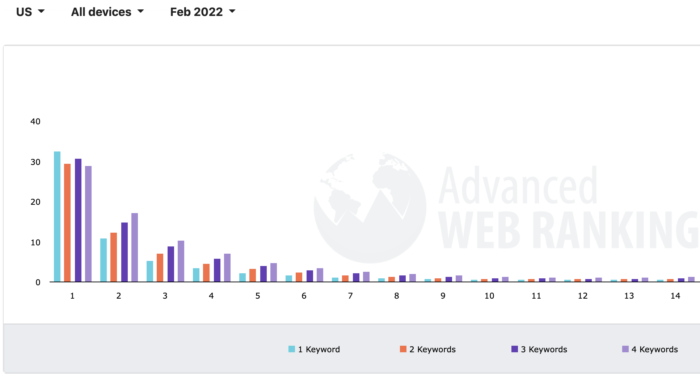
If you’ve been focusing all your marketing resources on short, popular keywords, it might be time to make the switch.
The best part? Long-tail keywords typically have less competition—so your website will likely rank higher than sites that only optimize their content for generic, overused target phrases.
Check out my free tool, Ubersuggest, for some extra help.
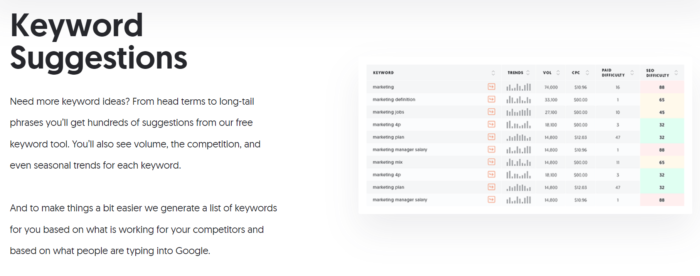
Topic Gaps
When people think of content gaps, this is typically what comes to mind first. When analyzing your website for topic gaps, ask yourself the following questions:
- Is the site covering all the topics readers are interested in?
- Does the site have comprehensive content for readers at all levels?
- Are the topics relevant to readers’ current interests?
Media Gaps
Recent studies show nearly 3/4th of users prefer to learn about a product or service by watching a video instead of reading a text post.
Imagine what you’re missing out on by not including attention-grabbing media in your content!
Plus, the power of video (and visual) marketing is only growing over recent years.
Data from Google shows watch time for shopping-related videos on YouTube grew by more than 5X over the past few years in the United States.
This is a huge wake-up call for all the content marketing teams out there to find media gaps in your content and fix them by adding images, videos, infographics, and other non-text-based media in their posts.
5 Methods for Finding Content Gaps
Now you know what content gaps are, why they’re important, and what you should be looking for.
Let’s look at how to find and fix them.
1. Run a Content Gap Analysis Using an SEO Tool Like Ubersuggest
If you’re worried you’ll have to spend many hours poring through data, manually analyzing every piece of content you’ve ever posted, I have some good news for you.
Free and paid online tools like Ubersuggest will do this job for you.
Ubersuggest offers a number of features that let you dig into your website’s data to quickly find problem areas.
For instance, Ubersuggest can help you generate reports for keywords, browse top-performing content and even analyze your competitor’s site.
The process for using my tool is simple.
- First, visit the Ubersuggest homepage.
- Next, enter the domain name or keyword you want a report on.
- Click “View all” or select the appropriate filters at the top of the report.

- Finally, click Export at the top of the report to store the information elsewhere.
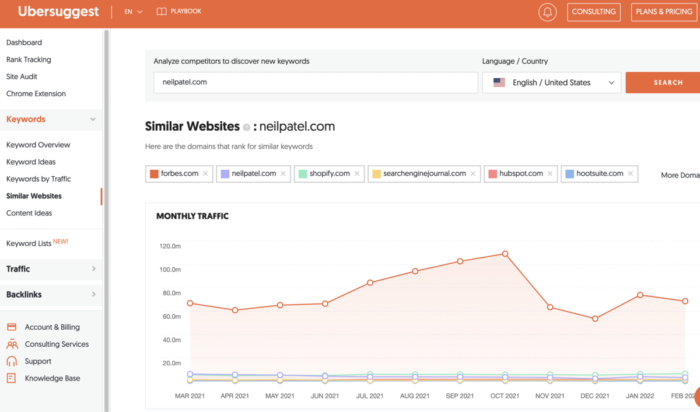
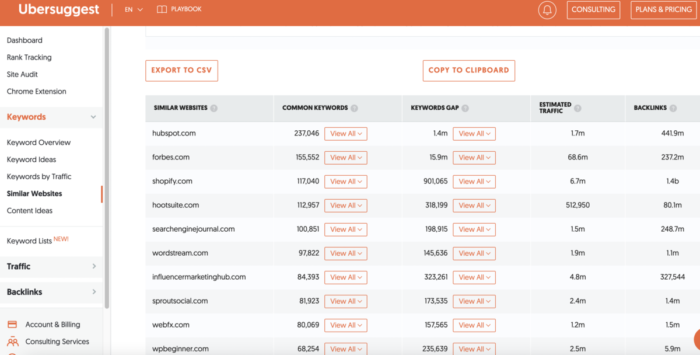
How to Fix Keyword Content Gaps:
- include new keywords in upcoming content
- update old content with missing keywords
- change your keyword optimization strategy
2. Audit Your Customer Journey and Identify Content Missing from the Funnel
Not all content gaps are as easy to fix as keyword content gaps. The key here is to dive deeper into your customer journey to figure out what your target readers need at each stage of their buying process.
Not every customer visits your website ready to make a purchase. Some are just curious while others are comparing your products with the competition.
For best results, you want to make sure you have content for each of these stages. You need posts that make users aware of your products and services.
Even USA.gov took this approach to figure out what content they were missing.
Let’s use Neil Patel as an example. New visitors to his website may be wondering what his companies are all about. This About page helps them find the information they need.

After this, you also need content for users comparing options. This can be as simple (and powerful) as a “vs” article. You can offer comparison points for well-known competitors.
Buy Me a Coffee does this well with an attractive comparison page featuring their top competitor Patreon.
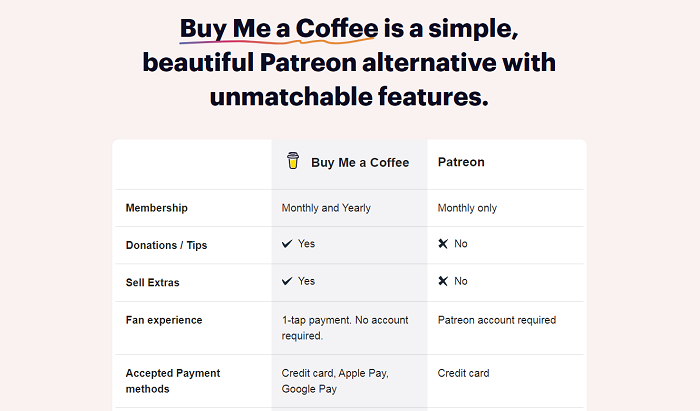
How to Fix Content Gaps:
- First, map your customer journey and ensure you have content on your website that appeals to visitors at each step.
- Second, create posts for each stage of the buying process that you don’t already have good content for.
- Finally, use customer surveys, feedback forms, polls, research from original sources, etc. to find data and information that supports the content you want to create.
3. Manually Search Competitor Websites to Identify Content Gaps
It can be hard to figure out what’s missing from your content on your own.
That’s where you can get help from the competition!
It’s quite simple.
Just see what your competitors are doing and apply those strategies to your own website.
You can do this manually by visiting competitor websites and noting what is missing from your own site.
For example, you may visit another SEO agency’s page and see they’re covering Google’s most recent algorithm update, but you haven’t yet.
How to Find and Fix Content Gaps Through Manual Competitor Research
- First, make a list of competitors to analyze manually. If you aren’t sure who you should consider, Google some of the most important keywords you target and see who else is ranking for them. You can also use SEO tools to help you find competitors.
- Next, visit each competitor’s page and make a list of topics your website is missing.
- Finally, brainstorm with your team about how to create a page on the same topic in a different or better way.
Be careful, though.
Competitors can provide inspiration for new content ideas, but avoid copying exactly what they do. A competitor may be getting great results with a particular keyword, but it doesn’t mean you should always create similar content. Think critically about whether what your competitor is doing is even applicable to your website.
4. Use Google Search Console
Did you know you can use the Google Search Console to perform a content gap analysis?
I’ll show you how.
First, log into Search Console and click “Search Results” on the left side of the page.
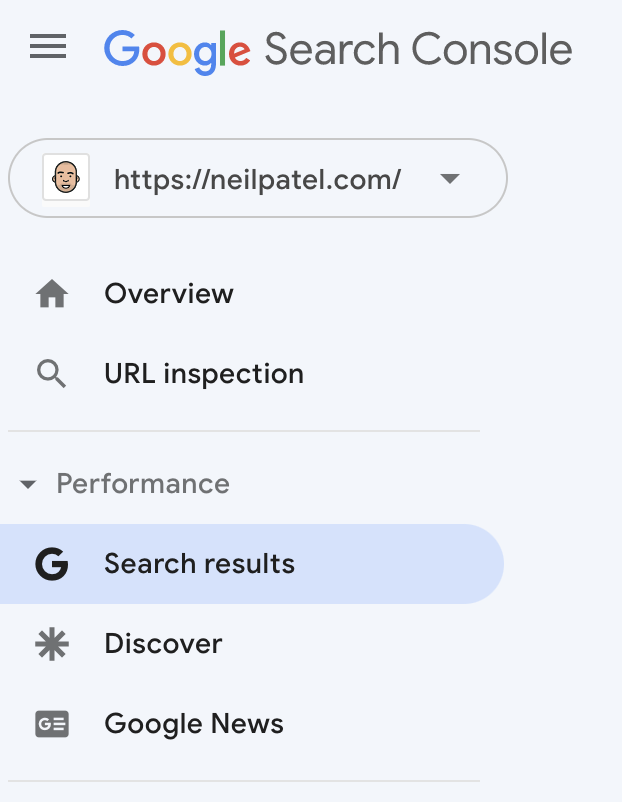
Next, click the “+ New” next to “Search type” and “Date range” (which you can modify).
When the box pops up, click “Page.”
Enter the URLs for your top-performing pages, one at a time.
When the results populate, see what keywords you’re ranking for on that page.
Go to the page on your website or in your CMS and search for all of your top keywords from Search Console (either top clicks or impressions).
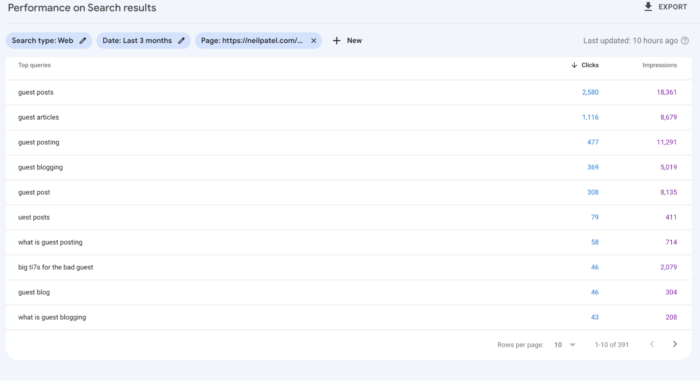
Finally, go to the post on your website and make sure the content is related to your top-performing keywords. Odds are, some of the keywords you rank for will not actually be covered on the page.
Once you identify the keywords you’re ranking for that are not covered on the page, create content that does by either creating a new post or adding a section to your existing one.
5. Perform a Self Content Audit
When was the last time you poked around your own website to see if there are any obvious topics you aren’t covering?
Using fancy analysis tools and checking out your competitors’ strategies sounds cool, but sometimes it can be easier to perform an audit on your own content. This can help you find problem areas in your current approach and improve the process when uploading content in the future.
For instance, you can start by updating old reviews on your page. Studies show 79 percent of consumers trust online reviews as much as they believe in personal recommendations, so updating outdated reviews can increase customer trust in your website.
Content Gaps Frequently Asked Questions
How do I fill a content gap?
You can fill a content gap by uploading new content, adding text or media to your existing page, changing your approach to finding keywords, and incorporating new marketing strategies from your competitors.
What tools do I need to find content gaps?
Free and paid SEO tools like Ubersuggest can help find content gaps through competitor analysis, keyword research, and SEO audit features. You can also perform these functions manually with the help of offline tools like spreadsheets.
What kinds of content gaps are most important to fix?
Content and keyword gaps are the most important to fix as having a good content and keyword strategy is crucial for better rankings on search engine result pages. Data shows less than one percent of users visit the second page on Google so it’s best to optimize your content and keywords to get on the first page.
How bad is it to have content gaps?
Having content gaps can make it difficult to attract new readers, retain your current readers, and encourage them to convert. If your page has significant content gaps, your readers may feel impatient or frustrated and move on to a competitor’s site to find what they’re looking for.
Conclusion: Content Gaps
Content gaps can lose you valuable customers and the potential revenue your business would earn from their purchases.
To avoid this:
- Use SEO tools like Ubersuggest to find content gaps.
- Perform manual audits of your website and your competitor’s websites to find gaps.
- Analyze your keyword strategy with Google Search Console to drive traffic and revenue.
Using these methods, you should be able to generate plenty of new content ideas and drive more traffic to your website.
Which method for filling content gaps are you going to try first? Let me know!
from Neil Patel's Digital Marketing Blog https://ift.tt/TXcRPDH
via IFTTT
No comments:
Post a Comment